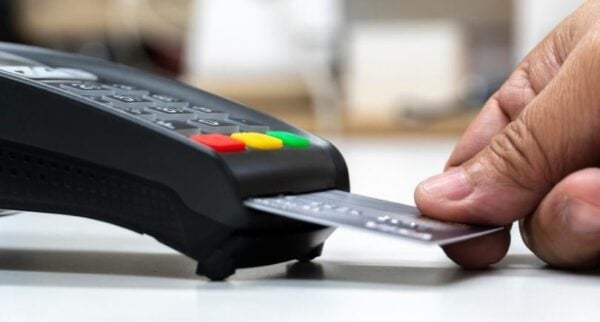Credit card jargon can be confusing, but when it comes to some concepts – such as, “Are credit cards fixed or variable rate?” – it’s important to understand the ins and outs. In this case, that’s because the difference between variable and fixed rates may end up saving (or costing!) you money. So let’s dive right in and unpack all of this with some commonly asked APR questions.
What is a fixed-rate credit card?
A fixed-rate credit card is a card offering a fixed interest rate, meaning the APR does not fluctuate. Instead, the rate remains the same for the amount of time you carry a credit card balance or loan. By law, card issuers must lock APRs for an account’s first year, but that doesn’t mean a fixed-rate card never increases rates. With that said, credit card issuers must notify customers of rate increases and give them 45 days before the rate hike takes effect.
This grace period allows consumers to:
- Opt out of the card, close the account and pay off the balance at the old rate.
- Open a different card and transfer the balance from the fixed-rate card.
- Stay with the fixed-rate card and higher APR.
What is a variable-rate credit card?
A variable-rate credit card is a card offering a variable rate which changes with the index interest rate. Variable rates are directly connected to the prime rate, which is an interest rate set by banks, and in your credit card’s case, the prime rate is set by the Federal Reserve. So, if the prime rate increases your variable rate credit card’s annual percentage rate, or APR, will likely increase. The frequency of change varies, depending on current economic factors. In the case of variable-rate credit cards, if the rate does fluctuate, your credit card issuer is not required to provide you with a 45-day warning. Instead, your monthly statement will indicate your current rate.
How do I know if my credit card has a fixed rate or variable rate?
These days, nearly every credit card features a variable rate tied to the prime rate. If you do find the rare gem that offers a fixed rate, it likely touts that fact clearly on marketing materials or its webpage. To find out for sure, start by looking at your credit card’s terms and conditions. This information will clearly be stated in the card’s fine print in the interest rates and interest charges section – usually the first section on a fine print page. In the Annual Percentage Rate (APR) box you’ll see something like “13.99% – 23.99% Variable APR,” or “Your APR will be 13.99% to 23.99%, based on your creditworthiness. This APR will vary with the market based on the Prime Rate.” On the other hand, for a fixed-rate APR, you’ll see something like “23.99% Fixed APR.”
If you aren’t positive that what you’re looking at is a fixed rate or variable rate, you can always call customer service and ask. That said, most credit cards offer a variable rate. If you find a credit card with a fixed rate, you’ll probably quickly know as it’ll likely be promoted somewhat heavily in the marketing materials.
How are APRs decided?
First the Federal Reserve decides on the prime rate and then your credit card issuer decides on the card’s margin, which is the percentage above the prime rate that a credit card charges.
The difference between what the credit card charges, and what the prime rate is, is called the margin. So, if the prime rate is 4% and your card’s APR is 15%, the margin is 11%.
Credit cards decide on the margin depending on your credit history. Those with an excellent credit score will likely have a lower margin than someone with a poor credit record.
Credit cards keep that margin for their customers, so if the Federal Reserve increases the prime rate by .25%, your card will likely increase your APR by the same percentage.
Which is better, a fixed-rate credit card or a variable-rate card?
Short answer: Neither is better than the other, but realistically, you’ll probably want to get a variable- rate credit card.
Of course, if you’re not thinking about credit cards all the time, you’re probably thinking, “Who are you kidding? I want a low fixed-rate credit card. I don’t want a credit card with a variable rate, which means my interest rate could change at any minute and go higher.”
But that type of thinking is a trap you want to be careful about falling into.
First of all, as noted, fixed-rate credit cards can have their rates raised. You get one year where it’s truly fixed, and then the credit card issuer needs to give you a notice 45 days before the rate goes up. So you could still have a credit card rate climb plenty throughout that second or third year.
A low fixed-rate credit card, in other words, may only truly be a low fixed-rate credit card for a period of time. Then, it’s anybody’s guess as to what might happen to the rate.
Also worth remembering—most credit cards offer variable rates, and so if you go searching for a fixed-rate credit card, you won’t have all that many to choose from. You’re going to be bypassing a lot of variable-rate credit cards that offer generous cash-back rewards or benefits or robust welcome offers, or all three.
Now, that doesn’t mean you shouldn’t look for a fixed-rate credit card, if that’s important to you. That said, as with any credit card feature, like if you’re searching for a credit card with cell phone protection or one that offers cash back, you need to look at the whole picture. How’s the annual fee? Is there a welcome bonus? Are there generous rewards?
Finally, and maybe most importantly, ask yourself – why do I really want a fixed-rate credit card? If you have a lot of revolving debt, and you want to pay it off, you probably should look for a balance transfer credit card. There are cards out there that offer a 0% APR on balance transfers for as long as 21 months, which means you’re protected for far longer than with a typical fixed-rate card. You just want to do your best to pay everything off before the introductory period ends or you’ll pay the regular ongoing APR on any balances that remain.
Now if you have no debt, but you are assuming that you will carry debt, and so you think it’s better to have a fixed-interest rate than a varied interest rate, you should seriously rethink that.
If you can help it, you don’t want to ever carry any revolving debt, period.
Carrying revolving debt for a long period of time is just going to damage your credit score. The way to have a credit card and never regret it is to pay off your debt every month — and hopefully have a credit card that offers cash back, miles or points so that you’re also earning rewards whenever you spend money.
In other words, low fixed-rate credit cards may be nice to have, but you really need to think about all of the features that a credit card may offer you.
Can a fixed-rate credit card increase its rates?
Yes. Despite many cardholders thinking that fixed-rate credit cards can’t change – it’s a fixed rate, after all – the rate actually can change. By law card issuers must lock APRs for an account’s first year, but then all bets are off. You do have a 45-day warning that a rate is going to go up, which would allow you to get another credit card if you wanted, but you may not find it practical to continually be searching for fixed-rate credit cards.
So, if there’s a fixed-rate credit card that you want and like, by all means, go for it. If you’re searching for a fixed-rate credit card, however, because you think you’ll never see your annual percentage rate climb again, you would be wrong.
How to protect yourself from a rising variable APR
You can protect yourself from a rising variable APR by obviously looking at fixed-APR credit cards – and applying for one. Generally, though, you’re only going to have the same fixed APR for a year, and then you may find that the card raises its rates enough that it’s only fixed in name.
Really, the best way to protect yourself from a rising variable APR is to pay off your credit card debt every month, without fail. It’ll help your credit score if you do, and you won’t waste any money paying interest.
That’s the thing. If everybody paid off their credit cards every single month, it wouldn’t matter if the APR was 99%. You’d pay the credit card off every month, and you wouldn’t owe any interest. It’s just that plenty of people do carry some revolving debt, or even a lot, and so cardholders understandably would prefer to have a predictable and as a low as possible APR. And you should want a credit card with a low APR, if you can get it. Nobody is suggesting that APRs don’t matter.
If you are often carrying revolving debt, and you want to protect yourself from a rising variable APR, you really just need to pay attention to what the Federal Reserve is doing. If you hear the Federal Reserve is raising rates, you’ll know that your credit card’s interest will soon eventually climb, too. (But it’s not all bad. Your savings account’s interest rate should also go up.)
So what should you do if you learn or suspect that your credit card’s variable interest rate will go up? You really have three options.
- Make sure you’re paying everything off every month. If the credit card’s variable interest rate goes up, it isn’t great, but if you never carry revolving debt, it shouldn’t matter to you too much.
- Start shoveling more money toward the revolving debt that you are carrying, so that you can pay it off faster. Our credit card payoff calculator can help you create a realistic payoff plan.
- Look around for a new balance transfer credit card with a lower interest rate and transfer your revolving debt to that.
If you know you have a large purchase on the horizon that you won’t be able to pay off immediately, you could also consider applying for a card with an introductory 0% APR offer on new purchases. This would give you extra time to pay off purchases, interest free. Again, just make sure you pay off any balances before the introductory period expires, or you’ll be responsible for the full rate of the ongoing APR on whatever balance you carry.
Can I ask for a lower interest rate?
Absolutely. It never hurts to call your customer service line and talk to a representative. As for what the answer will be, that’s tough to predict. If you’re always paying your bills on time, though, and you’ve been a customer for a while, your odds are far better than if you’re constantly late with payments.
Granted, there’s a weird logic to that. If you have a high interest rate and revolving debt, you’re going to owe more, and it may be harder to make your payments, and a lower interest.


